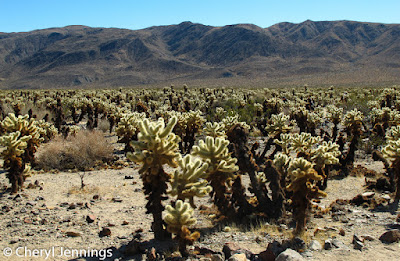The Bajada Nature Trail was my first stop in Joshua Tree
National Park. It was a short trail but
I learned the basics of the desert and a few more plant names. A bajada is a slope at a mountain’s base
formed from eroded sand and gravel. They
usually have more moisture and therefore more variety of plants and animals in
the dry wash area such as this one.
I found my first Joshua Tree National Park lizard here.
I believe it is a Southern Sagebrush Lizard (Sceloporus graciosus). I found many more of them later on in the
park. In fact I began to search them
out.
My next stop was the Cottonwood Visitor Center and a hike down to Cottonwood Spring
where I spotted this Western Fence Lizards.
where I spotted this Western Fence Lizards.
Cahuilla Indians used these springs as evidenced by the mortars in the granite rock. The sign along the trail read “Cahuillas believed
that everything in their world contained a spirit and that all spirits deserved
respect. When picking an edible plant, they would quietly pray to its spirit.
The prayers would include an explanation of why the plant was being picked and
an apology for using it. Whenever possible, only a part of a plant was taken.
The Cahuillas would try to leave behind enough seeds so that the plant could
reproduce. Their respectful attitude toward other forms of life enable them to
live here with little negative impact on their environment. “ I don’t
pick desert plants for food but I have had a long time habit of thanking the creatures
I photograph for their patience and apologize for scaring them. I also try to talk to them while taking the
photo, it kind of sooths and steadies me and hopefully them as well. Below are a couple of the mortar holes.
I was pleasantly surprised to find these lichens growing on
the shady side of one of the granite boulders. My friend Jane will appreciate
these.
In another direction along a dry wash I came across these two egg cases. I have no idea what they are and if anyone knows please leave a comment. They two were found on granite rock about waist high.
Turkey Flats was my next roadside stop.
Out of the corner of my eye I saw some movement, searched and found a Common Side-blotched Lizard (Uta stansburiana),
the most beautiful lizard I found so far. West Virginia does not have a lot of lizards so these were all new to me and a little easier to chase down than a salamander.
I was below 3,000 in the eastern end of the park within the
Colorado Desert, a subdivision of the Sonoran Desert that I visited while in Tucson. It is characterized by Ocotillo, Brittlebush,
and Creosote, much like Anza-Borrego State Park. Driving closer to the transition to the
Mojave Desert in the western section of the park came to the Cholla Cactus
Garden. They were everywhere and had
begun to bloom.
“What you come to see on the surface is not what you come to
know…the desert is time, exposed time, geologic time. One needs time in the
desert to see.” ---Terry Tempest Williams



















+DSCN5800+for+blog.jpg)




1 comment:
YES YES YES! Love the TTW quote and all of these pix and info.
I made the Cholla blossoms my background!
Post a Comment